I woke in Topeka on day two of Kansas, but the sixth day off from work, and finally felt completely rested enough to take on Kansas. Always within these trips there is a tension between seeing every corner and site the state offers and catching up on sleep and life. This year had been especially difficult, as there were so many things to take care of at home before I left, then a long drive and high temperatures. So I had booked a hotel in Topeka for two nights so Tamu had someplace air conditioned to stay while I headed out to explore.
But first, upon the recommendation of the hotel’s visitor map, Tamu and I set out to Lake Shawnee for his walk before the day became hot. The Lake Shawnee Recreational Area was not far from our hotel, and it offered a biking/walking path around its perimeter. 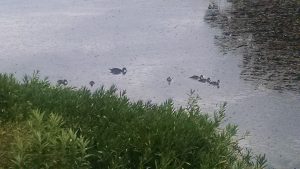 So Tamu and I started walking from the nearest parking area, enjoying the lake. Along the path, we stopped being next to the lake, and instead were circling around the golf course. When we reached the 30 minute mark, I decided to press on rather than turn back because it seemed like we had come to a point on the lake directly opposite where we had parked. Fifteen minutes later, we reached our first map, and discovered I had misjudged the distance, and we had only covered about a quarter of the lake. It was now getting hot, and Tamu had no water, so we headed back. I became concerned about him, as he was stopping to roll in grass already, and we had a long walk. Fortunately, about an hour after we started our walk, a park employee drove near us in a hybrid jeep/golf cart, and I flagged her down to see if she could take us back to the car because the dog was really hot. Absolutely, she said, and I coaxed Tamu onto my lap in the front seat for the ride back along the same path. I learned from Dottie, our helpful park worker, that the ghost bike along the path
So Tamu and I started walking from the nearest parking area, enjoying the lake. Along the path, we stopped being next to the lake, and instead were circling around the golf course. When we reached the 30 minute mark, I decided to press on rather than turn back because it seemed like we had come to a point on the lake directly opposite where we had parked. Fifteen minutes later, we reached our first map, and discovered I had misjudged the distance, and we had only covered about a quarter of the lake. It was now getting hot, and Tamu had no water, so we headed back. I became concerned about him, as he was stopping to roll in grass already, and we had a long walk. Fortunately, about an hour after we started our walk, a park employee drove near us in a hybrid jeep/golf cart, and I flagged her down to see if she could take us back to the car because the dog was really hot. Absolutely, she said, and I coaxed Tamu onto my lap in the front seat for the ride back along the same path. I learned from Dottie, our helpful park worker, that the ghost bike along the path 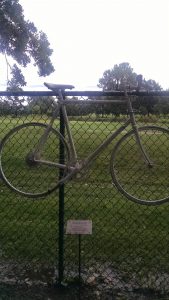 memorializes a woman hit by a cyclist while following the park rules about walking her bike in that stretch. Dottie got us back to the car without either of us overheating. Tamu got his cookie from Lucky Dog when we got back to the hotel as a treat. He was not sure about it when I left, but it was crumbs when I returned to the hotel that evening.
memorializes a woman hit by a cyclist while following the park rules about walking her bike in that stretch. Dottie got us back to the car without either of us overheating. Tamu got his cookie from Lucky Dog when we got back to the hotel as a treat. He was not sure about it when I left, but it was crumbs when I returned to the hotel that evening.
I set out to a museum dedicated to about the only thing I know about Topeka, The Brown v Board National Historic Site. I was thrilled to learn that the school had a full museum and was so easy to access. Brown v. Board of Education of Topeka, KS is the 1954 Supreme Court decision that desegregated schools. In the late 19th century, the court had ruled that schools could be separate but equal under Plessy v. Ferguson, and that decision fueled segregation, which generally created unequal schools and facilities for blacks. The Monroe Elementary School, a blacks-only school that was the subject of one of five lawsuits that were consolidated into this particular case, sits in a historically black neighborhood of Topeka. The neighborhood developed from land purchased in the 1860’s by the Ritchie family, New England abolitionists who worked the Underground Railroad during the Bleeding Kansas era. Their home was not open that day, which was a disappointment. The school itself was actually a lovely facility, particularly in 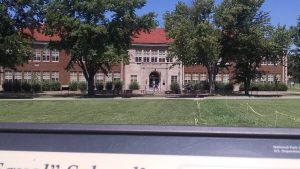 comparison with the other schools involved in the case. It was included because the NAACP legal team, led by Thurgood Marshall, wanted to make the case that, even in the rare case where separate was equal, segregation causes irreparable harm to children who experience it and needed to be ruled as unconstitutional by the courts. So the case included sociological research on the subject and the Topeka school. The National Parks has, as usual, set up a wonderful museum in the former school, with the gymnasium used for video explaining slavery, resistance, the Civil War, Jim Crow, segregation, and the Civil Rights movement. Then other displays, set up in classrooms, provide more detail about
comparison with the other schools involved in the case. It was included because the NAACP legal team, led by Thurgood Marshall, wanted to make the case that, even in the rare case where separate was equal, segregation causes irreparable harm to children who experience it and needed to be ruled as unconstitutional by the courts. So the case included sociological research on the subject and the Topeka school. The National Parks has, as usual, set up a wonderful museum in the former school, with the gymnasium used for video explaining slavery, resistance, the Civil War, Jim Crow, segregation, and the Civil Rights movement. Then other displays, set up in classrooms, provide more detail about 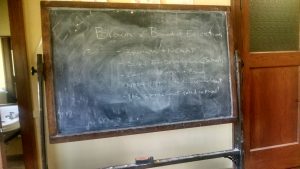 segregation and the lawsuit and how the decision affected the nation since 1954. Two items were particularly memorable, the videos detailing each of the school systems involved in the final case were fascinating. Also, to give the effect of what the first black students to attend newly-desegregated schools experienced, one of the displays requires visitors to walk down a short hall with life-size film on either side of the white resistance shouting epithets and screaming to go back where you belong. It is particularly chilling. This year marks 100 years of the National Park Service, and this proved to be my only NPS site during the trip. It was a great one. The next day, I encountered the white elementary school that was the subject of the lawsuit, but I’ll leave those details to Kansas’ Day 3.
segregation and the lawsuit and how the decision affected the nation since 1954. Two items were particularly memorable, the videos detailing each of the school systems involved in the final case were fascinating. Also, to give the effect of what the first black students to attend newly-desegregated schools experienced, one of the displays requires visitors to walk down a short hall with life-size film on either side of the white resistance shouting epithets and screaming to go back where you belong. It is particularly chilling. This year marks 100 years of the National Park Service, and this proved to be my only NPS site during the trip. It was a great one. The next day, I encountered the white elementary school that was the subject of the lawsuit, but I’ll leave those details to Kansas’ Day 3.
I headed off to downtown Topeka for lunch and a peek at the capitol. 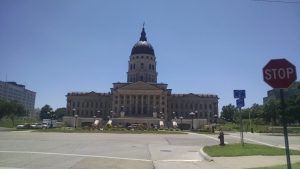 Then I had a decision to make. There were two more sites to see in Topeka, but the NPS guide had also told me I could make it to Abilene, site of the Dwight D. Eisenhower Presidential Library and Museum, fairly quickly. Because I would have Tamu with me for the trip the next day, I decided to soak up some more 20th century US history there for the afternoon. The site is located at Eisenhower’s boyhood home and includes that, an overview of World War II at the Library, an extensive museum, the Place of Meditation–where Dwight and Mamie Eisenhower are buried–and various outside pylons memorializing Eisenhower’s role in World War II and as President of the United States. Because of my timing, I started at the Library, which is mostly dedicated to scholars, and closes first. The World War II displays on the second floor were not specifically related to Eisenhower, and seemed a bit dated as displays. I walked through the quickly while waiting for my house tour to begin.
Then I had a decision to make. There were two more sites to see in Topeka, but the NPS guide had also told me I could make it to Abilene, site of the Dwight D. Eisenhower Presidential Library and Museum, fairly quickly. Because I would have Tamu with me for the trip the next day, I decided to soak up some more 20th century US history there for the afternoon. The site is located at Eisenhower’s boyhood home and includes that, an overview of World War II at the Library, an extensive museum, the Place of Meditation–where Dwight and Mamie Eisenhower are buried–and various outside pylons memorializing Eisenhower’s role in World War II and as President of the United States. Because of my timing, I started at the Library, which is mostly dedicated to scholars, and closes first. The World War II displays on the second floor were not specifically related to Eisenhower, and seemed a bit dated as displays. I walked through the quickly while waiting for my house tour to begin.
Eisenhower’s boyhood home was very charming. It seemed rather grand to me, but the docent 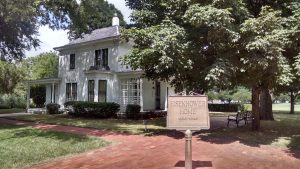 helpfully explained that it seems that way because the rest of the neighborhood was knocked down to make room for the rest of the buildings on the site, and it was actually on the wrong side of the tracks. Eisenhower spent his childhood with his five brothers in the house, and his parents remained there into their old age. Eisenhower left it for West Point as a young man, and his career never brought him back to Abilene for anything other
helpfully explained that it seems that way because the rest of the neighborhood was knocked down to make room for the rest of the buildings on the site, and it was actually on the wrong side of the tracks. Eisenhower spent his childhood with his five brothers in the house, and his parents remained there into their old age. Eisenhower left it for West Point as a young man, and his career never brought him back to Abilene for anything other 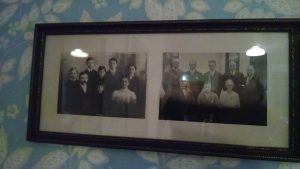 than a visit, until he was finally buried there. From the home, I headed off to the Museum itself. When I arrived, the docent who checked my ticket OK’d me for a return visit the next day because he did not think I had enough time to really take it all in. He turned out to be right. Because it was a Presidential Library and Museum, I had not anticipated the size of the collection about Eisenhower’s military career. I simply forgot. I wandered through the displays detailing his education, early career, rise in the ranks, the war in Europe, D-Day, Mamie, and his retirement. I was just getting the presidential part when it was time to get back to the gift shop before it all closed. So I resolved to come back. My initial impression of the museum was that it was quite a collection, but that it seemed dated. Oddly, the history needed
than a visit, until he was finally buried there. From the home, I headed off to the Museum itself. When I arrived, the docent who checked my ticket OK’d me for a return visit the next day because he did not think I had enough time to really take it all in. He turned out to be right. Because it was a Presidential Library and Museum, I had not anticipated the size of the collection about Eisenhower’s military career. I simply forgot. I wandered through the displays detailing his education, early career, rise in the ranks, the war in Europe, D-Day, Mamie, and his retirement. I was just getting the presidential part when it was time to get back to the gift shop before it all closed. So I resolved to come back. My initial impression of the museum was that it was quite a collection, but that it seemed dated. Oddly, the history needed 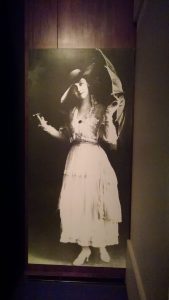 refreshing. There was no glaring errors; it seemed like it needed editing, but then Eisenhower’s career prior to the White House needs time. On my way out, the docent told me that they are closing it down in the coming year to do an extensive renovation. Sounds good. I am glad it was not closed for my Kansas year!
refreshing. There was no glaring errors; it seemed like it needed editing, but then Eisenhower’s career prior to the White House needs time. On my way out, the docent told me that they are closing it down in the coming year to do an extensive renovation. Sounds good. I am glad it was not closed for my Kansas year!
In general, I find that Presidential museums offer some really interesting souvenirs, and the Eisenhower Library did not disappoint, with its selection of WWII, 1950’s, and Kansas memorabilia. I came away with a Rosie the Riveter lunchbox and, quite possibly, the best souvenir ever: Pez
dispensers of the US Presidents from FDR to LBJ. This may be the high water mark in souvenir kitsch for me. I cannot imagine how anything could top this, and I smiled the rest of the trip over it. (I should note that, once back at work, a colleague pointed out to me that the box contains a number on it, suggesting that one can purchase an entire collection of US Presidents as Pez dispensers. The possibility of a Millard Filmore or Grover Cleveland just makes me too happy. For now, however, I look at Truman and JFK on their 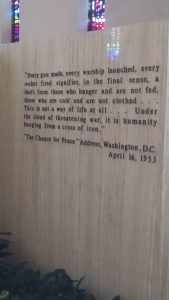 plastic stands, and I am inspired.)
plastic stands, and I am inspired.)
The day was–as usual–painfully hot, but Abilene still had much to offer. I walked to the grave site, and stopped to pay my respects. Then I wandered around the grounds visiting the outdoor markers on the site. Finally, I had exhausted the place for this day. I planned to head out of Abilene, but headed over to the railway station adjacent to the Eisenhower site. I am glad I did, because it featured Abilene’s history as a western cattle town. It was my first reminder of being in the Wild West, and it was self guided. I walked around reading about gun fights and railroads and cattle. So far, I had not taken in that part of Kansas, and I was not sure I would have enough time to do so, but was glad to have the reminder while I could still 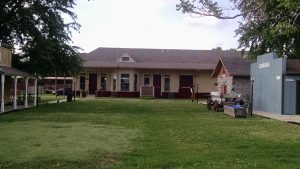 plan for it.
plan for it.
I drove home, hoping to make a winery stop, but it was closed. Clearly, I had a two reasons to head back in this direction tomorrow. I just hoped I could find Tamu enough shade to stay happy.
